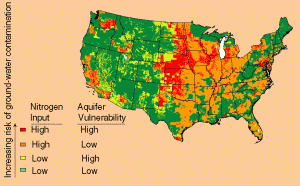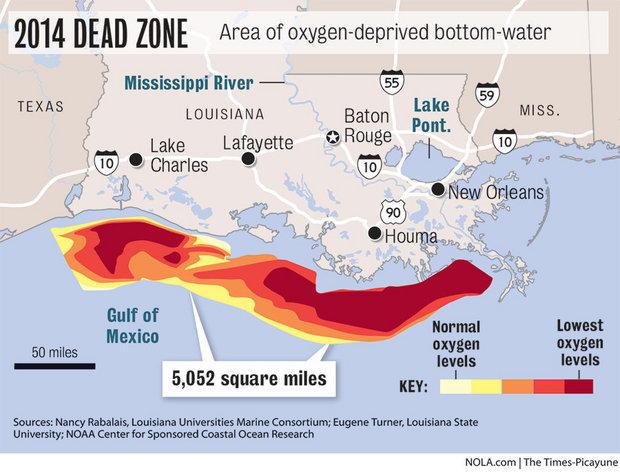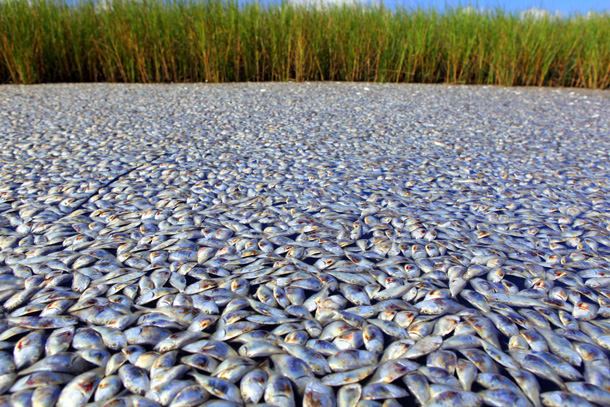What are Nitrates?
Nitrates are chemical compounds containing nitrogen and oxygen. They’re found in a variety of natural and man-made sources. The latter significantly contributes to increased nitrate concentrations in ground water. Some of the major anthropogenic nitrate sources are sewage discharge, industrial effluents, and fertilizers.
Nitrates are generally harmless, but consumption of high concentrations can have adverse health effects, such as Blue Baby Syndrome in infants. Regulatory standards adopted by the United States Environmental Protection Agency (EPA) define acceptable nitrate levels in drinking water as 10 mg/ liter.
The map below illustrates the risk of nitrate contamination of ground water throughout the United States. The aquifers in the Midwest and parts of the west and northeast are highly vulnerable to nitrate contamination. Regular testing and water quality monitoring can establish the actual level of ground water nitrate concentration. Another factor is the depth of the well that ground water is extracted from. The contamination concentration has an inverse relationship with well depth.

Health effects
Nitrates are often associated with Blue Baby Syndrome in infants. Recent research studies have linked nitrates to adult health disorders like thyroid and bladder cancer.
Tackling the issues
Cures
Treatment (by filtration) and non-treatment options are available for removing nitrates from contaminated water. Treatment can be done via reverse osmosis, ion exchange, chemical reduction, etc. The non-treatment option requires nitrate dilution by blending the contaminated supply with a non-contaminated water source, creating a lesser or non-contaminated source. The caveat is that none of the mentioned methods will result in complete eradication of nitrates from the water source.
Prevention
Agricultural input
Limiting the amount of nitrogen applied as fertilizer helps reduce the nitrogen leaching into ground water. Farmers view nitrogen as a safety net that prevents crop failure, and would rather use too much than too little. A chart depicting nitrogen use versus resulting yields will show the lowest amount of nitrogen required to maintain high yields. Progressive farmers using this approach would help promote the spread of this practice.
Sewage Management
Stringent measures could curb the disposal of untreated or poorly treated sewage. Industrial effluents should be monitored for nitrate concentration and tight penalties imposed for non-conformance to regulatory standards.
Cascading Effects
A lawsuit filed by Des Moines is an example of state wide fall out from high nitrate concentration. Des Moines water works utility holds three counties responsible for the Raccoon River’s (Des Moines major water supply source) excessive nitrate concentration. To combat the nitrates, the utility runs a denitrification plant. This has caused an increase in operating costs. They allege that farm groundwater runoff from the three upstream counties are major pollution point sources. Efforts to work with the farmers to reduce the nutrient discharge from their farms have not yielded the desired results.
Besides bearing legal responsibility, farmers may have to spend more for conservation practices. The extra expense without an increase in yield will decrease their competitive advantage. Farming has many variables and wafer thin margins.
Adding nitrate control measures would be overwhelming. A combination of state subsidies for conservation measures, farm runoff regulation, and collaboration between all the concerned stakeholders is paramount.

The influence of excessive nutrients isn’t limited to the state of Iowa. It manifests in different forms with fallouts at a much larger scale. An example is the dead zone in the Gulf of Mexico. The Mississippi river and its tributaries drain almost 40% of the United States. They carry water rich in nitrates and phosphates into the Gulf of Mexico. The nutrient rich waters have resulted in algal blooms and a subsequent loss of marine life. Fishermen must venture farther into the sea for their catch, resulting in increased time at sea and money for fuel, and decreased profit margins.

Measures
The state, citizens, farmers, and industries should work together to achieve the following items:
- Process of periodic monitoring of nitrate concentration in water sources.
- Decrease the discharge of nitrates/ other nutrients laden runoff – from farms, industries, and lawns.
- State based regulation with all the stakeholders under its auspice.
- State driven incentives for using best practices in nitrate usage, treatment, and discharge.
A sense of the big picture is required to understand the cascading effects of one’s actions. This is achieved through large scale awareness of “what happens because of what I do.” It should be promoted through various persuasive measures, though hard measures may prove effective. It’s good to educate people on the reasoning behind hard measures, so they’ll get everyone to be more responsible for their actions. Ultimately, a combination of hard and soft measures is necessary to reduce nitrate discharge and contamination.
References:
- http://water.usgs.gov/nawqa/nutrients/pubs/wcp_v39_no12/
- https://www.epa.gov/nutrient-policy-data/estimated-nitrate-concentrations-groundwater-used-drinking
- http://beyondpesticides.org/dailynewsblog/2016/10/nitrate-pollution-groundwater-linked-birth-defects-cancers-thyroid-problems/
- http://water.usgs.gov/nawqa/nutrients/pubs/wcp_v39_no12/https://www.epa.gov/nutrient-policy-data/estimated-nitrate-concentrations-groundwater-used-drinking
- http://www.reopure.com/nitratinfo.html
- http://civileats.com/2016/07/29/controversial-des-moines-water-works-lawsuit-calls-for-farmers-to-clean-up-drinking-water/
- http://www.nature.org/ourinitiatives/regions/northamerica/areas/gulfofmexico/explore/gulf-of-mexico-dead-zone.xml